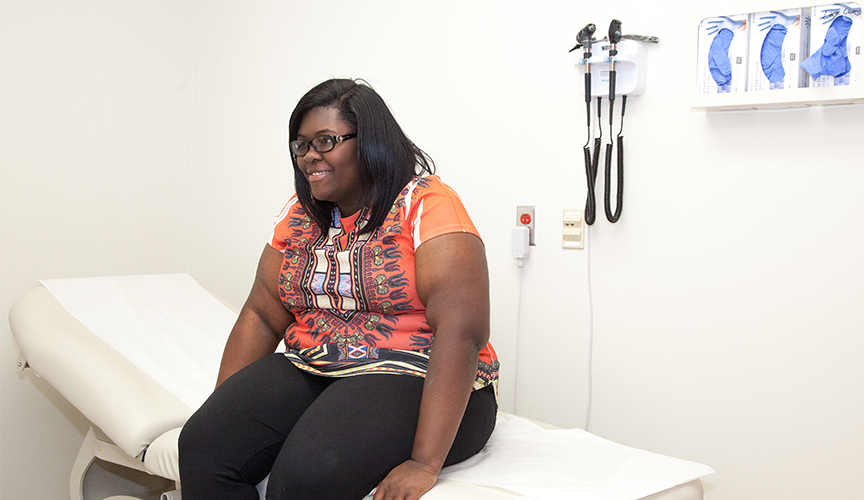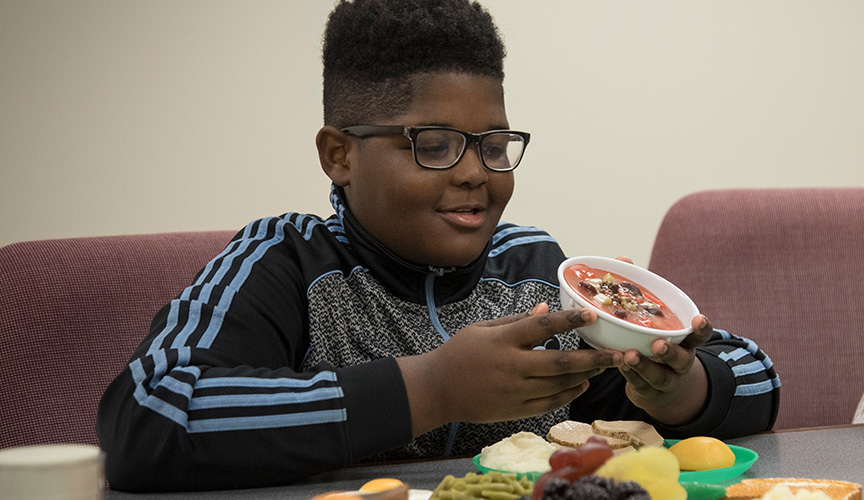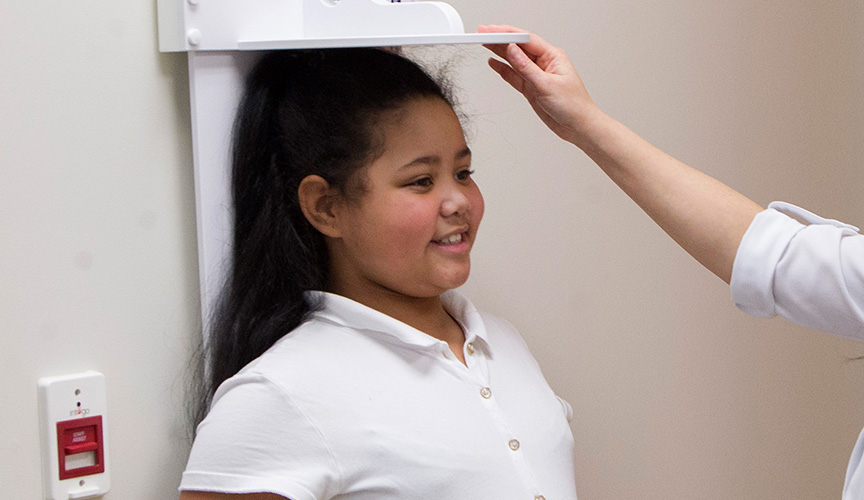Obesity
Healthy Lifestyle Clinic Makes Great Strides

Since the Healthy Lifestyle Clinic was founded in 2014, the faculty and staff have made a number of achievements. The first two years of the clinic were spent establishing reputation in the community and educating people on the nature of weight and obesity management, which resulted in an enormous positive response. Obesity Medicine Specialist Thomaseo Burton, PhD, joined the Healthy Lifestyle Clinic in 2015 and was involved in the initial outreach to the community.
Narayana and investigators performed two studies comparing TMS to two commonly used noninvasive techniques, functional magnetic resonance imaging (fMRI) and magnetoencephalography (MEG). fMRI is widely used as a validated alternative to more invasive methods. fMRI cannot be used with patients who have contraindications such as metal plates or pacemakers, and brain tumors can create signal artifacts due to vascular abnormalities. Patients are required to lie still inside a large, loud machine, which can be difficult for young children. Similarly, MEG requires patients to remain still. Some children must be sedated to undergo fMRI and MEG, which limits the types of language tasks that can be performed. By contrast, TMS has a frameless stereotaxic navigation system, shows fewer signal artifacts and does not require patients to remain still. TMS also offers the ability to perform a wider variety of language tasks.
“We emphasized that obesity management isn’t something that just happens in the clinic. The family, community and school need to be involved to make the necessary lifestyle changes,” said Burton.
The Healthy Lifestyle Clinic’s initial community outreach resulted in numerous referrals that kept providers within the clinic busy but ultimately exposed some growing pains.
“We received an overwhelming response and ended up with a huge waitlist. Patients would be referred to our clinic by their primary care physicians, but they couldn’t get an appointment for six to nine months after the initial referral. It created a lot of frustration for everyone,” said Burton.
Providers in the Healthy Lifestyle Clinic came up with a new triage system and started scheduling waitlisted patients and their families for group orientation. In orientation, patients and their families learn about the Healthy Lifestyle Clinic’s multidisciplinary approach to weight management and receive basic tips on how to promote a healthy lifestyle, such as drinking more water, avoiding sugary foods and beverages and engaging in regular exercise.
“The triage system allowed us to educate patients on why they were being referred and how the Healthy Lifestyle Clinic can help. It also helped patients decide whether the program was right for them. Some patients chose not to be involved, while others expressed motivation and started counseling. With this approach, we can now manage the flow of patients and contact most new referrals in 30 days or less,” said Burton
With the success of the triage system, providers in the Healthy Lifestyle Clinic are now looking forward to building relationships with primary care physicians in the Memphis area.
“The rates of pediatric obesity in Memphis are staggering. Realistically, we cannot see every child with obesity in Memphis and the Mid-South region. That’s why we are working to empower pediatricians to do some of this management,” said Burton.
By building partnerships with local pediatricians, the Healthy Lifestyle Clinic is spreading knowledge on simple lifestyle interventions that can improve children’s health. The clinic provides packets with information on healthy foods, simple exercise plans and goal setting. This information can help children and their families avoid unhealthy beverages such as sugary fruit juice and empower physicians to advise these families in a manner consistent with weight management. With this strategy, the Healthy Lifestyle Clinic is poised for more growth and success in the future.
Families Fight Obesity with MEALS

Obesity Medicine Specialist Thomaseo Burton, PhD, and Exercise Physiologist Webb Smith, PhD, have developed a novel intervention to address obesity in the kitchen. The intervention, Multidisciplinary Engagement and Learning/Mindful Eating and Active Living (MEALS), combines mindfulness, cooking techniques and education to teach children and their caregivers how to make healthier meals and engage in mindful eating. This program comprises two-hour education, cooking and discussion sessions once a week for three weeks that are tailored to fit the largely African-American and under-resourced communities served by the Healthy Lifestyle Clinic.
During the sessions, child-caregiver pairs receive a brief lesson on healthy living topics, mindfulness concepts and kitchen safety; a taste test of healthy foods prepared by a facilitator; meal preparation; and a dine-and-discuss session led by a facilitator. The mindfulness component of the program focuses on helping children become more aware of internal states and how to link these states to hunger, cravings and satiety, as well as how to increase awareness of the quantity and quality of food. The taste test portion encourages participants to use mindfulness techniques to explore the appearance, smell, texture and taste of the sample food. During meal preparation, children and caregivers work together to follow recipes and cook the food. The dine–and-discuss session again encourages participants to apply mindfulness techniques to manage portion sizes, eat the food and consider how their experience in the session relates to their experiences at home
This intervention is unique compared to traditional clinical management, which usually comprises brief counseling without an experiential component. MEALS also takes barriers to healthy eating, such as cost, time, wariness of new foods and access to ingredients, into consideration by using low-cost ingredients and familiar recipes. Following the pilot program, the facilitators plan to assess the impact of the intervention by measuring participant characteristics, caregiver feedback and youth feedback, with the hope of seeing meaningful improvement in participants’ health and well-being.
Predicting Obesity Before Birth

The Conditions Affecting Neurocognitive Development and Early Learning (CANDLE) study has produced multiple findings relevant to early childhood development. Supported by the Memphis-based Urban Child Institute, investigators at the University of Tennessee Health Science Center (UTHSC) and Le Bonheur have followed more than 1,000 mother-infant dyads and reported on the impact of maternal dietary patterns, demographic factors and gestational vitamin D levels on the development of infants and children in Memphis and Shelby County, Tenn. The data from CANDLE are being used to identify areas for intervention to promote healthy development in early childhood.
With colleagues at UTHSC and the University of California at San Francisco, Joan Han, MD, pediatric endocrinologist and director of the Pediatric Obesity Program, has published another study on the CANDLE cohort. This study focused on relationships between maternal metabolic factors, early childhood growth trajectories and obesity risk. Han and colleagues specifically focused on pre-pregnancy BMI, gestational weight gain and gestational diabetes based on previous research indicating the potential influence of these factors on long-term obesity risk in children. The investigators also sought to identify potential racial disparities in the effects of maternal metabolic factors. Unlike previous cohorts, the CANDLE cohort included both black and white infant-mother dyads, which allowed the investigators to look for differences.
The researchers grouped the infants based on three BMI growth trajectories (low BMI, moderate BMI and rising-high BMI) to explore potential associations with maternal metabolic factors. They found that mothers who were overweight or obese, had excessive gestational weight gain and gestational diabetes were more likely to have children in the rising-high BMI group. Next, the investigators computed the relative risk for each maternal metabolic factor associated with the rising-high BMI trajectory. This computation revealed pre-pregnancy obesity and excessive gestational weight gain were significantly associated with the rising-high BMI trajectory and increased risk of obesity at age 4 among the children, whereas gestational diabetes was only associated with increased risk of obesity at age 4. Moreover, as the number of maternal metabolic factors increased, the risk of being in the rising-high BMI group and being obese at age 4 increased. No significant differences were present between white and black subgroups in terms of the effects of maternal metabolic factors on growth trajectories or childhood obesity.
This study demonstrated maternal metabolic factors are related to child growth trajectories and the risk of childhood obesity. This study improved upon previous research by measuring BMI at several time points and adjusting for multiple confounders such as gestational age and birth weight. The investigators did not find racial disparities in the association of maternal metabolic factors, growth trajectories and childhood obesity risk, which may indicate equalization of obesity risk across all races and ethnicities. This finding could also be attributed to the high rates of obesity in the South for both groups or the smaller number of white versus black participants in this study. A promising implication of this research is that interventions targeting maternal metabolic factors may reduce the risk of childhood obesity, but further research is needed to explore this possibility.
Help us provide the best care for kids.
Le Bonheur Children's Hospital depends on the generosity of friends like you to help us serve 250,000 children each year, regardless of their family’s ability to pay. Every gift helps us improve the lives of children.
Donate Now
















